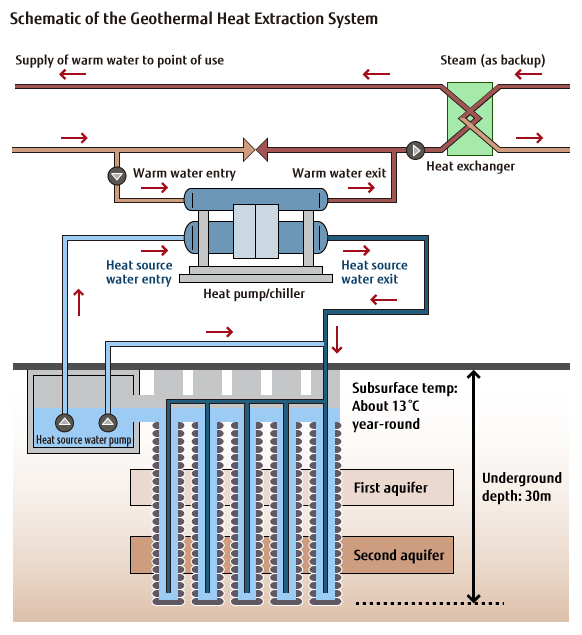Archived content
NOTE: this is an archived page and the content is likely to be out of date.
Geothermal Heat Extraction System
The Fujitsu Group is actively working to promote the use of renewable energies to help prevent global warming and ensure stable energy supplies.
Use of Geothermal Heat Gaining Attention as a New Renewable Energy Source
Renewable energy has been garnering increasing attention not only for reducing CO2 emissions but also for lessening energy supply-related risks. The Fujitsu Group, too, is promoting the use of renewable energy as a key objective of its Environmental Protection Program (Stage VI). As part of its commitment, the Group has deployed and is evaluating the performance of its first geothermal heat extraction system at the Nagano Plant in Japan.
In contrast to high-temperature geothermal heat used to generate electricity, the geothermal heat utilized by the new system is low-temperature heat found at relatively shallow depths in the Earth's crust, which stays at a fairly constant temperature year round due to the insulating properties of soil.
For this reason, it has long been used to preserve food, ice and other perishable items. In Japan, where annual precipitation is high, rainwater permeates the soil to become groundwater, which is stored in ample amounts. The thermal conductivity of groundwater is high, so it is easy to extract geothermal heat from it, meaning Japan enjoys favorable conditions for this form of energy. Heat extraction systems are relatively simple, so their cost performance is superior to other types of renewable energy. Geothermal systems therefore have great potential for more widespread use in the future.
At the Nagano Plant, attention turned to the potential use of this geothermal heat in water heater equipment for air conditioners in clean rooms that run around the clock.
Repeated Testing for Effective Operations
The strata under the Nagano Plant has aquifers in two places, between 3 and 10 meters and between 18 and 23 meters belowground, making it relatively easy to extract geothermal heat. The system utilized has 31 heat extraction pipes, which leverage corrugated coaxial double piping techniques and are embedded in the ground. The geothermal heat that is extracted by running water through these pipes is used to produce hot water via a heat pump. There is no concern about groundwater depletion with this system because it only extracts heat-not water-from the ground.
In October 2011, we began excavation work to bury the heat extraction pipes and began operating the system at the end of January 2012. When the system first went into operation, heat could not be extracted in planned amounts, but after running tests from various angles, the cause was found to be the flow velocity of the circulating water used for heat extraction. A circulation pump was installed, and this resulted in a dramatic improvement in the amount of heat extracted. The system is currently projected to generate roughly 155W of energy per 1 meter-long pipe using this system, which should cover 90% of the air conditioning load of the plant's clean rooms.
Fujitsu Facilities Ltd., which installed and tested the system, intends to acquire and accumulate expertise in geothermal systems and establish technologies for utilizing geothermal heat.

Toward Widespread Use of Geothermal Heat
 Members of geothermal heat extraction system installation project
Members of geothermal heat extraction system installation project
Compared to generating hot water via its existing gas boiler system, test calculations suggest that deploying the geothermal heat extraction system will enable Fujitsu to reduce annual fuel consumption by roughly 47kL and annual CO2 emissions by roughly 120 tons. Geothermal heat is expected to provide exceptional benefits for heating and cooling at public facilities, hospitals and other buildings and as a source of heat for agricultural greenhouses, which require round-the-clock temperature management.
Moving forward, we will put the system into wider use at the Nagano Plant and explore its horizontal deployment to other Fujitsu Group locations, while actively promoting its adoption in a variety of other settings.
![]()
Project Leader, Facility and Environment Services Division, Fujitsu Facilities Ltd.
Yasushi Yazawa

Geothermal heat offers superior stability and cost performance because it changes little from season to season or day to day. Another advantage is that dead space is not created since geothermal heat extraction pipes are embedded in the ground.
We initially struggled to extract more heat after installing the system, in part because it was our first attempt at using geothermal heat. We will develop the operational know-how to effectively harness geothermal heat, utilizing it when we embark on the horizontal in-house deployment of the system.

